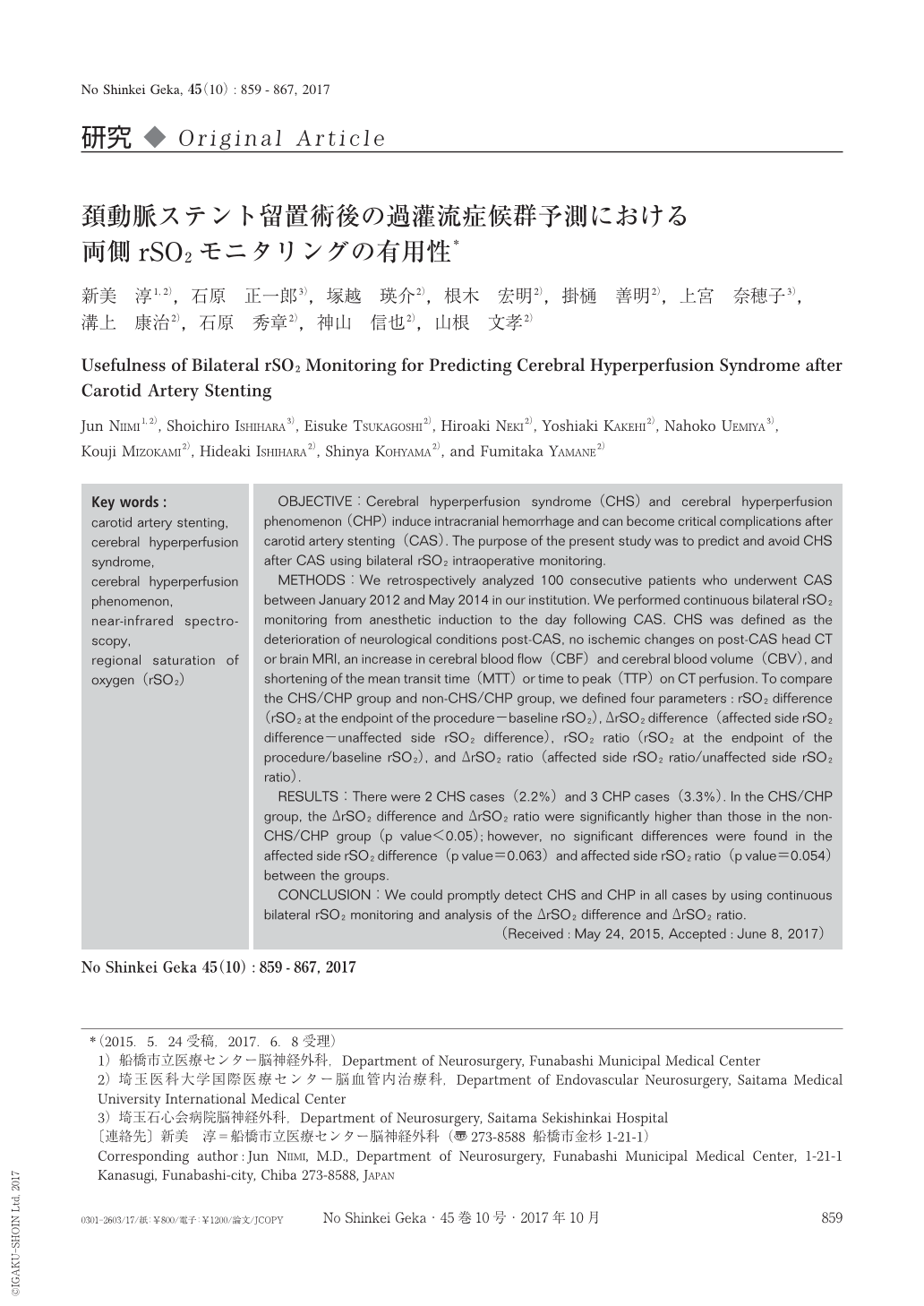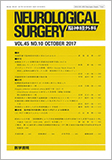Japanese
English
- 有料閲覧
- Abstract 文献概要
- 1ページ目 Look Inside
- 参考文献 Reference
Ⅰ.緒 言
頚動脈狭窄症に対するステント留置術(carotid artery stenting:CAS)は,頚動脈内膜剝離術(carotid endarterectomy:CEA)とともに,現在では確立した治療法である3,6,26).その周術期管理においては,虚血性合併症のみならず過灌流症候群(cerebral hyperperfusion syndrome:CHS)に十分注意する必要がある.CEA術後の過灌流症候群は1981年にSundtら23)によって報告され,その発症率は0.2〜18.9%と報告されている25).CAS術後の過灌流症候群は,1990年代後半から報告され始め2,15,17),0.4〜11.7%に発症し,頭蓋内出血を来す例は0〜11.7%と報告されており,ひとたび頭蓋内出血を来すと致死的となり得る1,4,9,11).
CASおよびCEA術後の過灌流症候群の予測および早期発見のために,positron emission tomography(PET),single photon emission computed tomography(SPECT),transcranial Doppler(TCD),transcranial color-coded real-time sonography,computed tomography perfusion(CTP)などの有用性が報告されている4,10,11,13,21,24,25).近年は,近赤外線分光法(near-infrared spectroscopy:NIRS)を用いた局所混合血酸素飽和度(regional saturation of oxygen:rSO2)モニタリングの有用性に関する報告が散見されるようになってきた8,14,19,21).rSO2モニタリングは非常に簡便かつ低侵襲,低コストである.また,術中から術後まで持続的にモニタリングが可能であり,リアルタイムに頭蓋内血流動態の変化を捉えることができる7,8,21).これまでのrSO2モニタリングの報告は,患側値のみの変化に注目しているものが多いが8,14,19,21),rSO2はそのベースラインの個人差が大きく,さらに周術期においては酸素投与や血圧変動などにより計測値が変動しやすいため7,12,16,22),その値の解釈には注意を要する.
OBJECTIVE:Cerebral hyperperfusion syndrome(CHS)and cerebral hyperperfusion phenomenon(CHP)induce intracranial hemorrhage and can become critical complications after carotid artery stenting(CAS). The purpose of the present study was to predict and avoid CHS after CAS using bilateral rSO2 intraoperative monitoring.
METHODS:We retrospectively analyzed 100 consecutive patients who underwent CAS between January 2012 and May 2014 in our institution. We performed continuous bilateral rSO2 monitoring from anesthetic induction to the day following CAS. CHS was defined as the deterioration of neurological conditions post-CAS, no ischemic changes on post-CAS head CT or brain MRI, an increase in cerebral blood flow(CBF)and cerebral blood volume(CBV), and shortening of the mean transit time(MTT)or time to peak(TTP)on CT perfusion. To compare the CHS/CHP group and non-CHS/CHP group, we defined four parameters:rSO2 difference(rSO2 at the endpoint of the procedure−baseline rSO2), ΔrSO2 difference(affected side rSO2 difference−unaffected side rSO2 difference), rSO2 ratio(rSO2 at the endpoint of the procedure/baseline rSO2), and ΔrSO2 ratio(affected side rSO2 ratio/unaffected side rSO2 ratio).
RESULTS:There were 2 CHS cases(2.2%)and 3 CHP cases(3.3%). In the CHS/CHP group, the ΔrSO2 difference and ΔrSO2 ratio were significantly higher than those in the non-CHS/CHP group(p value<0.05);however, no significant differences were found in the affected side rSO2 difference(p value=0.063)and affected side rSO2 ratio(p value=0.054)between the groups.
CONCLUSION:We could promptly detect CHS and CHP in all cases by using continuous bilateral rSO2 monitoring and analysis of the ΔrSO2 difference and ΔrSO2 ratio.

Copyright © 2017, Igaku-Shoin Ltd. All rights reserved.


